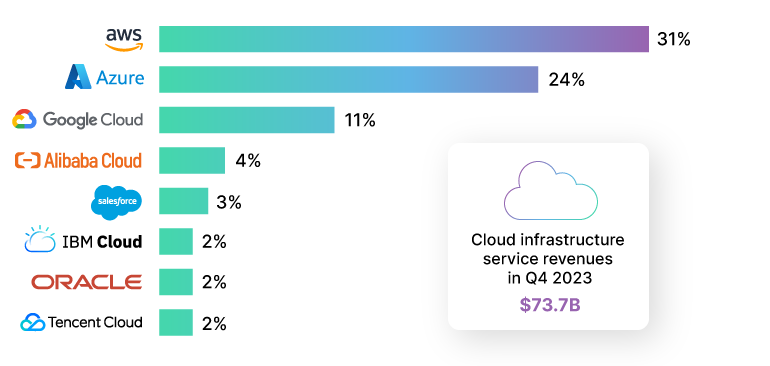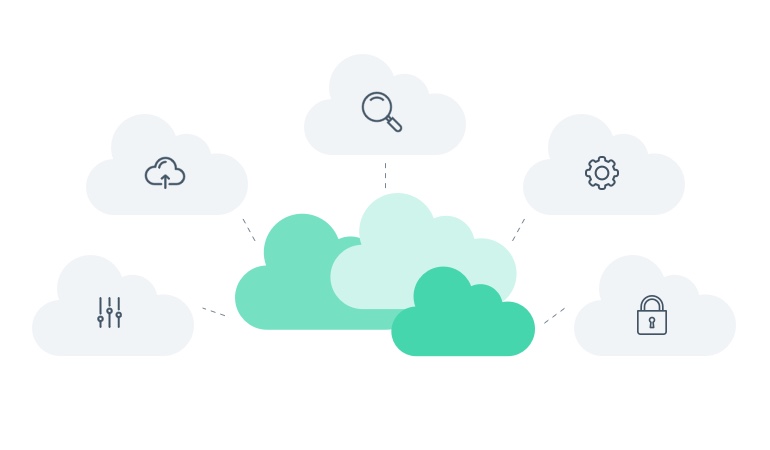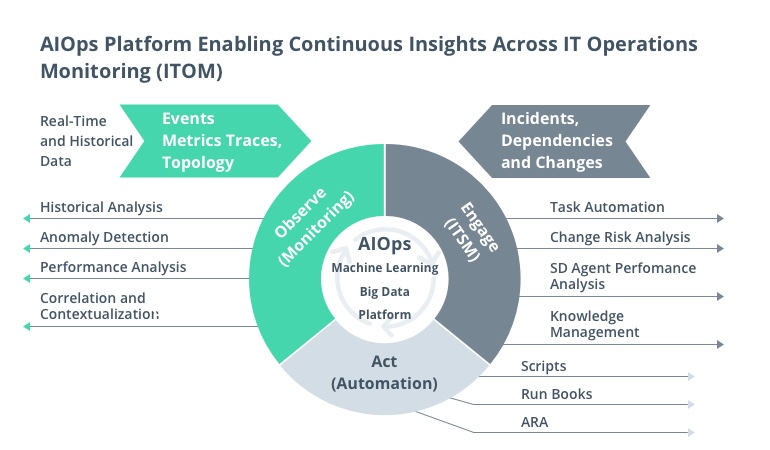With more and more companies recognizing the benefits of hosting their resources in cloud, adoption of cloud technologies is constantly accelerating. Reports say that 94% of businesses worldwide are using cloud computing in one way or another. However, the time has come to consider using not only one cloud but several.
Multi-cloud computing is the approach to building cloud infrastructure made up of more than one cloud service from more than one cloud service provider. Freedom to choose the cloud vendor for a particular task gives next-level flexibility and robustness by ensuring that every job is done in the most efficient way possible.
The advantages of multi-cloud infrastructure are clear, and today over 76% of enterprises using cloud computing have opted for multi-cloud. This statistic alone may convince you to consider the multi-cloud approach for your business, but let’s look closer at the benefits you may enjoy by distributing your infrastructure over several clouds.
Why a multi-cloud solution?
There are many cloud providers on the market today. However, the names that immediately come to mind in the context of cloud computing are Amazon Web Services, Microsoft Azure, and Google Cloud Platform. Indeed, these are the true leaders in this area, together holding more than 60% of the global cloud market.
Global market share of cloud infrastructure service providers

Source: Statista
Naturally, businesses choosing a cloud provider begin with comparing the features and opportunities offered by each of the major players, deciding which provider best fits their needs. All offer hundreds of cloud services and have flexible pricing plans; however, different providers shine in different areas.
For example, AWS platform is unrivaled as an infrastructure as a service provider, claiming more than 50% of the total IaaS market according to Statista’s latest report. Microsoft Azure is known for its superb integration capabilities, allowing companies to form coherent platforms joining cloud and on-premises resources. Google Cloud Platform tops the ratings in data analytics and machine learning.
Such amazing features from different providers make the choice even harder, until you consider going multi-cloud. Indeed, why not benefit from scalable platforms coupled with powerful analytics?
This is the core reason for the growing popularity of the multi-cloud approach to building enterprise infrastructure; however, there are many more benefits of a multi-cloud strategy.
Key advantages of multi-cloud management solutions

Adopting a well-designed multi-cloud strategy increases freedom in choosing necessary features, strengthens control over cloud costs, latency, and resource availability, and might improve the overall customer experience. However, to fully enjoy the advantages of a multi-cloud strategy, we recommend partnering with a professional cloud software development company that can consult you on the most optimal selection of cloud providers and services and help you set up infrastructure that meets your needs.
With a properly organized multi-cloud solution, you will experience a new level of cloud computing advantages.
Higher performance
When you work with several cloud providers for your applications, you get access to their geographic coverage enabled by their distributed networks of data centers. Multiple clouds ensure greater coverage, with the ability to choose the data center closest to the end user, thus increasing service availability and minimizing latency.
Choice of best services
In a multi-cloud setup, you get access to more than one cloud provider and all their services. As a result, you can choose those services that are most suitable for the specific task, comparing the characteristics of services in several offerings and joining multi-cloud capabilities for a combined benefit.
For example, for some tasks, you might need fast delivery of high-bandwidth content, for which you select AWS CloudFront. Other applications may require a hybrid infrastructure combining cloud and on-premises environments, for which Microsoft Azure will be perfectly suited.
Enhanced resilience
The use of multiple clouds is a natural means of ensuring redundancy for fast and effective disaster recovery. When used as a failover solution, multiple clouds provide enterprises with a highly flexible, scalable, and instantly available backup for data and apps.
Moreover, a multi-cloud approach eliminates the risk of vendor lock-in, which makes the business overly dependent on a single cloud provider. In the event of a failure, it is extremely unlikely to affect the entire infrastructure if it is comprised of services by several vendors.
Regulatory compliance
When you are legally obligated to comply with regional regulations, such as the GDPR, the CCPA, or other laws and standards, using multiple clouds can be a viable solution, taking care of both data residency and data governance requirements. The wider geographic coverage provided by several cloud service vendors allows you to choose data storage locations in the required jurisdiction.
Access to the best cloud features without vendor lock-in
With a multi-cloud strategy in place, you enjoy the best features and services offered by each cloud vendor and avoid vendor lock-in. As a result, you can benefit from the most pioneering features and technologies implemented by different providers and choose those that meet your business’s requirements.
Main challenges of multi-cloud computing

When choosing a multi-cloud experience, you must consider some challenges that come with this otherwise effective approach. Still, the benefits of using multiple clouds will surely make up for the possible complexities if you work with a reputable cloud software development company to configure your infrastructure.
Security
The greater complexity of a multi-cloud configuration results in proportionately more stringent security requirements. Although cloud providers offer highly secure services out of the box, the practice of dynamically distributing data and workloads between different clouds requires a solid, holistic approach to cybersecurity. Reliance on several clouds elevates the importance of regular failover drills.
Management complexity
Any multi-cloud solution requires thoughtful and professional setup, configuration, and continuous oversight. With assets being stored in different clouds and workloads being assigned to varying cloud resources, orchestrating these processes becomes increasingly difficult. You need to make sure that your IT staff are well-versed in all relevant cloud platforms and can maintain an effective interplay between them.
Cost control
Even a single cloud account can be confusing in terms of the recurring and ad hoc costs of services, subscription levels, quotas, etc. When you use two or three clouds in parallel, it is extremely important to control your spending and shuffle workloads in an optimal manner. Although, you can maintain control over your cloud spending if you closely monitor service usage and plan resource consumption.
Loss of vendor loyalty bonuses
It’s not uncommon for cloud service providers to offer exclusive deals and rates to loyal clients. Those offers can include heavily discounted storage, priority service, or other perks. Using services of other cloud providers in addition to your primary one might lead to losing some of your former privileges due to a reduction of business with the former vendor. Weigh your options carefully before deciding to use multiple clouds.
Identity management
In a multi-cloud setup, identity and access management (IAM) may become complicated, as different vendors might have different IAM practices and requirements. To maintain infrastructure security and integrity, it’s vital to implement and maintain a strong system of infrastructure assessment and management in a diverse cloud environment or to invest in a reliable single sign-on solution to control access to all cloud services.
It may seem that using a multi-cloud strategy is a challenge even for mature organizations. However, with meticulous cloud readiness assessment, planning, consideration of multiple factors, and a clear understanding of the ultimate goal, this transition may well become the best thing you’ve ever done to boost the potential of your IT infrastructure and make it ready for the future.
Multi-cloud vs single-cloud
If you’re weighing your options in either exploring the versatility of a multi-cloud strategy or remaining with the more straightforward configuration of a single cloud, here’s a side-by-side comparison of the key factors that can tip the scales:
| Single-cloud | Multi-cloud | |
|---|---|---|
| Performance | Overall cloud infrastructure performance is determined by the capabilities of the selected provider. | Optimization is possible by mixing the strongest features of several providers. |
| Scalability | Scalability is limited by the maximum capacity of the provider’s resources. | Combining resources of several providers may result in greater scalability. |
| Management | Managing cloud infrastructure may be simpler, as you only need to follow the guidelines of a single provider. | Cloud management may be more complex due to the need to accommodate the requirements of several providers. However, under the guidance of an expert cloud engineer, multi-cloud management may be done with confidence. |
| Cost | Single-cloud setups are generally less costly. | With bills from multiple providers, the overall cost may be higher; however, you will have access to more services and resources. |
| Security | In a single cloud, security measures may be easier to introduce. | When data is distributed among several providers, additional security measures may be required to ensure reliable protection. |
| Resilience and disaster recovery | Data redundancy is restricted to the number of data centers within the provider’s network, which lowers overall resilience. With a single point of entry, single clouds may be more vulnerable to outside threats. | Combining networks of several cloud providers ensures greater resilience in the event of failure. A multi-cloud system is also better protected from external attacks due to data distribution over several networks. |
| Regulatory compliance | While seemingly easier in a single-cloud environment, you may face some compliance-related restrictions due to geographic limitations. | Multi-cloud coverage ensures greater flexibility in data storage, facilitating data residence compliance. |
The growing role of AI in multi cloud management
Is there a way to automate cloud management or even keep cloud infrastructures running autonomously? Fortunately, a lot of DevOps pundits want to improve multi-cloud orchestration and are working hard to make that happen. Today, there is no doubt that the clouds of tomorrow will be partially or fully controlled by AI and that DevOps will evolve into AIOps.
Hardly anyone in the industry will argue that managing a massive multi-cloud infrastructure is a breeze. More often than not, it’s like trying to play several musical instruments at once. With the snowballing amount of data coming from various infrastructure elements, it becomes increasingly hard to react to issues timely and adequately, let alone make educated decisions regarding workload allocation and data re-routing.
AI-based automation aims to solve these issues by leveraging the power of advanced self-learning algorithms embedded at the core of cloud management solutions. Driven by machine learning, these algorithms excel in processing large volumes of monitoring data, detecting even the most subtle deviations from established policies, and taking proactive measures to eradicate operational inefficiencies.
This initiative gave birth to such remarkable concepts as AIOps and intent-based networking. The latter is a DevOps framework or operational paradigm that helps mold company-wide networking goals and rules into actionable policies. These are then used by AI-based network management tools for ongoing monitoring, issue detection, scaling, troubleshooting, and self-healing. In multi-cloud environments, the reaction speed and ability to automatically resolve issues at an early stage are the most important factors ensuring operational stability of complex, dynamically changing infrastructure.

There is no doubt that, with time, the importance of AI-powered network management solutions will grow, as will the adopction of intent-based networking. These new approaches to managing multi-cloud environments provide companies with never-before-seen flexibility, agility, and insights into their physical and virtual network assets while reducing risks and lowering maintenance overhead.
Other emerging multi-cloud trends
The obvious benefits of multi-cloud computing are driving developers to find ways to make such infrastructure configurations even more efficient by powering them with cutting-edge technologies. Enhanced with the latest innovations, multi-cloud environments become greater than the sum of their parts, laying the foundation for next-level solutions.
Edge computing
The very concept of edge computing is bringing data processing closer to the data source, and this is why the multi-cloud approach fits edge computing like a glove. As an edge network grows, adding new servers, it becomes necessary to ensure a high-performance, low-latency cloud connection that allows for processing gigabytes of data collected by various IoT-powered devices.
With a multi-cloud environment, edge networks become more productive, as they use distributed services of multiple providers, leveraging the best connectivity from all of them. Industries such as automotive, logistics, and manufacturing especially appreciate the multi-cloud benefits for the boost in productivity and scalability this approach delivers.
Serverless computing
Serverless computing has been a buzzword for quite a while, with many businesses choosing to hand over infrastructure maintenance to cloud providers and focus on their production processes, innovations, and experiments. This trend has sprouted such concepts as function as a service (FaaS) and backend as a service (BaaS), which are gaining increasing traction.
In a multi-cloud setup, serverless computing is getting its share of popularity too. This approach leverages the advantages of both strategies, enabling the flexibility and efficiency of multiple clouds and the reduced overhead of a serverless environment.
Open Source CQRS Framework for Cloud-Native Microservices
Containerization
Software developers have been using container solutions to create portable applications and achieve higher scalability for quite a while. This approach has also proved beneficial in a multi-cloud setup, enabling application portability between clouds to gain dynamic storage capacity and handle traffic peaks.
Another significant benefit of container technology is the support of cloud-native development. With containers, developers can immediately deploy and test software in a cloud environment with no need for offline work. In a multi-cloud infrastructure, it becomes possible to leverage container development to create solutions using features and services of multiple clouds.
Multi-cloud adoption checklist
To make your multi-cloud experience as beneficial as possible, keep in mind some of the key factors that contribute to your cloud success.
| Use automation tools | Automation facilitating enforcement of procedures and streamlines cloud governance, policies across multiple cloud services. |
| Enhance security measures | In addition to security mechanisms implemented by cloud providers, multi-cloud infrastructures need to be protected by network segmentation, end-to-end encryption, and multi-factor authentication. |
| Monitor cloud costs | To keep track of bills from several providers, establish a system for monitoring resource consumption, switches between clouds, and ROI on each cloud you are using. |
| Train your teams | A multi-cloud configuration might require a different approach from development teams, with a focus on the network as a cohesive environment rather than a collection of individual services. |
| Ensure regulatory compliance | The advantage of having access to data centers of multiple providers can backfire in the form of violating data residency laws. Make sure the convenience and costs of data storage do not outweigh compliance with regulatory requirements. |
So, is it time to go multi-cloud?
To answer the question from our technological point of view — yes, a multi-cloud strategy does pay off in a big way. It is a fail-safe method of overcoming the functional or cost limitations of a single cloud, and more and more companies will embrace it for its operational effectiveness and long-term cost savings.
A multi-cloud strategy does pose some challenges, but these are clearly outweighed by the benefits. The increasing complexity of cloud-based networks, including multi-cloud and hybrid models, will inevitably bring intelligent AI/ML-based management tools to the forefront and make AIOps the DevOps services of the future.
The cloud industry is advancing at an unprecedented pace as we see more and more cutting-edge innovations making their way into the mainstream. Get to know how Intellias cloud software development services will benefit your company’s operational efficiency and turn business into a strong asset. Contact our experts for more insights.



